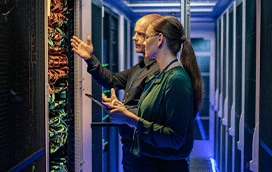Open source
Open source has become an integral part of enterprises' digital transformation. Businesses today increasingly use open-source technologies for data, networking, cybersecurity, operating systems, and several other requirements. It is leading the evolution of emerging tech like distributed ledger and the internet of things.
Evolution of Open source across the three horizons (H1 to H3)
H3
Driver of digital transformation
Key Patterns
- Deploy anywhere, on-premises, cloud, edge
- Enterprise-scale, integrated and interoperable technologies
- Full-scale, integrated functionality
- Leading future, innovative solutions
- Industry-backed umbrella foundations
Characteristics
- Network operations and interoperability
- Transformer architecture, self-supervised — AI
- AI/ML-based intelligent validation
- Decentralized, resilient operations
- Intelligent data, new databases
- UX-driven, responsive, citizen-developed functions and Application programming interfaces (APIs)
- Digital-first, remote-first infra, hyperautomation, data-at-core
H2
Production, planned usage
Key Patterns
- Hybrid cloud deployments
- As a service, backed by cloud service providers (CSPs)
- Broad, enterprise grade functionality
- AI-driven efficiency gain
- At par with proprietary solutions
- Large, interconnected foundations
Characteristics
- Transfer learning, explainable systems AI
- Full-scale functional and nonfunctional validation
- Integrated security for apps, cloud, network, edge
- Agile, AI-driven ops
- Unstructured data (NoSQL), Cloud DBaaS, and ELT
- Distributed, cloud-native microservices
- New compute paradigms, collaboration
H1
Nonproduction, citizen usage
Key Patterns
- Desktop-based open-source tools
- Siloed functionality
- Nonproduction, on-premises deployment
- Catching up on proprietary solutions
- Small, isolated foundations
Characteristics
- Data Lite - conventional AI
- Siloed, functional validation
- App security
- Traditional ops
- Relational data
- Monolithic, on-premises apps
- Virtual infrastructure
Key trends across open-source subdomains
Trend 1
Cloud-native modern apps gain wider acceptance
Cloud-native apps drive digital transformations across enterprises. This fuels the growth of open-source technologies across all layers of the IT stack, including infrastructure, platform, middleware, application, data, and operations. Backed by the cloud, the concept of MODERN APPS microservices gained traction with containers and docker
Trend 2
AI/ML usage increases in modernization and app development
AI and ML enhance reliability, automation, and efficiency across data analytics, LCNC, quality assurance, and digital experience (speech, vision, gestures, etc). Infosys Modernization Radar 2022 highlighted AI and ML as the third most popular investment area by enterprises, with 96% of businesses leveraging these technologies for their modernization goals.
Trend 3
Phased approach proves least disruptive during modernization
Businesses typically modernize their applications using three approaches: big-bang, phased, and coexistent. Big-bang can be a cheaper option, but it can cause serious risks of rewriting legacy systems and disrupting ongoing services. This approach is more viable for small and easy-to-replace applications. For large-scale modernizations, phased or coexistent methods are better options, as they offer minimal disruption to existing services.
Trend 4
HTAP demonstrates efficiency in real-time analytics
Hybrid transaction/analytics processing (HTAP) can reduce the time lag between a business event and its visibility in analytics. By combining the capabilities of a transactional database that provides high speed,atomicity-consistency-isolation-durability compliance, and SQL friendly interface with the broad analytical capabilities of an OLAP/data warehouse, HTAP reduces complexity and enables faster decision making.
Trend 5
AI/ML-driven data engineering gains prominence
Businesses today rely on an ecosystem of enterprises to deliver customer value. Each partner in this symbiotic ecosystem is a node that depends on internal information and shared intelligence from other partners. This forces these organizations to be data and intelligence-driven and be agile to respond.
Trend 6
Managed services from CSP to lower barriers to open-source adoption
CSPs are strengthening their PaaS portfolios by providing managed services for a wide range of open-source technologies, complemented by PaaS/marketplace solutions from the core committers organization on the CSP of choice.
Trend 7
Cloud continuum expands for distributed, polycloud, and edge systems
Cloud continuum has expanded seamlessly for distributed, polycloud, and edge systems. New architectures and topologies shape the cloud's evolution of new possibilities across private/public/hybrid/multicloud patterns and tap into a chain of distributed resources to the edge.
Trend 8
Software-defined and disaggregation of network elements to enhance cost efficiency, flexibility, and scaling
Telecom service providers and enterprises are increasingly looking at options to reduce CAPEX and OPEX on networks while reducing dependence on select vendors. Disaggregation and software defined abstraction enable them to have a choice of hardware and software.
Trend 9
AI/ML and orchestration systems empower extreme automation
Enterprises find it challenging to orchestrate multidomain end-to-end observability. Open-source libraries provide ML/AI algorithms (such as Spark) to create network-specific assurance use cases. Data management and dashboarding are increasingly using Kibana and Grafana as underlying components.
Trend 10
AIOps gain momentum with Open source
AIOps comprise seamless monitoring, data gathering from various apps, devices (sense), intelligent correlations, insightful analytics, and zero touch automation as the primary solution pillars. It is leveraging low-code, configuration-driven, cloudnative, open-source solutions to take enterprise Ops intelligence and productivity to the next level.
Trend 11
Open-source DevSecOps and MLOps become mainstream
While AIOps is bringing efficiency in operations, DevSecOps is helping development teams build on-demand infra, near real-time vulnerability detection, app lifecycle automation, automate mundane tasks, and ensures standards compliance.
Trend 12
Decentralized identity management to enable better privacy and security
Traditionally, personal identity information is managed by centralized organizations that could be public authorities or large private corporations. Third parties can authenticate the identity of individuals by verifying these credentials with the issuer. This centralized approach leads to privacy risks and makes these organizations potential targets for cyberattacks and identity theft.
Trend 13
Interoperable DLT networks to create portable, end-to-end decentralized applications
Currently, most DLT platforms and networks are not compatible with each other. This makes it difficult to develop portable solutions that can span across multiple networks while maintaining trust and security guarantees associated with DLT. For enterprises working with DLTs, it creates platform/vendor lock-in and requires them to maintain multiple versions of the same application.
Trend 14
Open-source becomes critical for technology standards and innovation
Open technology standards have become critical in resolving complexity stemming from ever-expanding technology sprawl. Several open-source foundations are leading the development of standards and aggressively pushing their adoption.
Trend 15
Open industry standards gain more recognition
Industry-specific standards have emerged recently. Industry players are building open standards and joint solutions to accelerate the innovation for specific industry use cases.
Download Insights
What's New
Latest White Papers, Tech Blogs and View Points

Subscribe
To keep yourself updated on the latest technology and industry trends subscribe to the Infosys Knowledge Institute's publications
Count me in!
















